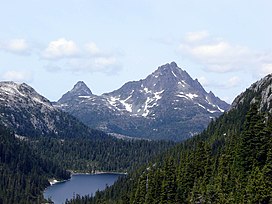Insular Mountains
Mountain range in Canada From Wikipedia, the free encyclopedia
Mountain range in Canada From Wikipedia, the free encyclopedia
The Insular Mountains are a range of mountains in the Pacific Coast Ranges on the Coast of British Columbia, Canada, comprising the Vancouver Island Ranges and Queen Charlotte Mountains. The Insular Mountains are rugged, particularly on Vancouver Island where peaks in Strathcona Provincial Park rise to elevations of more than 2,000 m (6,562 ft). The highest of these mountains is Golden Hinde on Vancouver Island, which rises to 2,196.818 m (7,207 ft).
| Insular Mountains | |
|---|---|
| French: Monts Insulaires | |
 Golden Hinde, south aspect, August 2006. | |
| Highest point | |
| Peak | Golden Hinde, Vancouver Island |
| Elevation | 2,196.818 m (7,207.41 ft) |
| Coordinates | 49°39′43.8″N 125°44′48.6″W |
| Dimensions | |
| Area | 133,879 km2 (51,691 sq mi) |
| Geography | |
| Country | Canada |
| Province | British Columbia |
| Parent range | Pacific Cordillera |
Although the Coast Mountain Range is usually referred to as the westernmost range of the Pacific Cordillera (since it is the westernmost range on the main landmass at that point), the Insular Mountains are the true westernmost range.[1]
These Insular Mountains are not yet fully emerged above sea level, and Vancouver Island and the Haida Gwaii are just the higher elevations of the range, which was in fact fully exposed during the last glacial period (maximum ice extent about 18,000 years ago) when the continental shelf in this area was a broad coastal plain.
The Insular Mountains formed when a chain of active volcanic islands (the Insular Islands) collided against the North American continent during the mid Cretaceous period. The type of rocks that form the Insular Mountains are turbidites and pillow lavas. Granitic plutons seldom occur in the Insular Mountains, unlike the Coast Mountains. The Insular Mountain range covers some 133,879 km2 (51,691 sq mi). It experiences frequent seismic activity, with the Pacific Plate and the Juan de Fuca Plate being subducted into the Earth's mantle. Large earthquakes have led to collapsing mountains, landslides and fissures.
During the last glacial period, ice enclosed nearly all of these mountains. Glaciers that ran down to the Pacific Ocean sharpened the valley faces and eroded their bottoms. These valleys were transformed into fjords when the ice melted and the sea level rose. Ice Age remnants may still be noted, such as the Comox Glacier in the Vancouver Island Ranges.

The Elk River Mountains, located in Strathcona Provincial Park, are sometimes classified as a range.[2][incomplete short citation]
Seamless Wikipedia browsing. On steroids.
Every time you click a link to Wikipedia, Wiktionary or Wikiquote in your browser's search results, it will show the modern Wikiwand interface.
Wikiwand extension is a five stars, simple, with minimum permission required to keep your browsing private, safe and transparent.